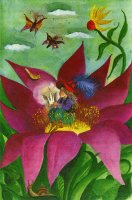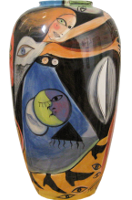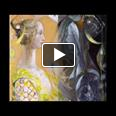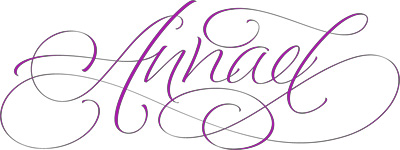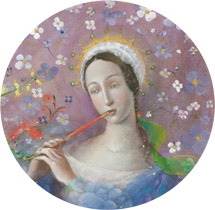A number of people have asked me in the past about the connection of music with my paintings. To explain the deep relation between music and visual art in my work is not as simple as it may seem: it is almost like trying to explain a musical piece – one can say "the composer expresses this and this", but such a description is not enough, it does not take one through the experience one has when listening to the music.
Because from a certain point of view music is a very abstract form of expression, if someone says they create visual art using particular music or even music in general, people immediately expect to see a similar form of expression: an abstract painting. Here a view predominates which makes it easy to imagine, for example, that musical harmonies and tones mechanically correspond to certain shapes and colours, or that music can or should only be expressed in vague daubs etc. These tendencies are especially strong when the music concerned is difficult or lacks singable melodies (e.g. modern or postmodern classical). In all cases the viewer is predisposed to agree, somehow "intuitively", that a painting may be after certain music when it is expressed in pure abstraction and remains inexplicable. When confronted by more figurative paintings, however, which have a concrete, recognizable image that can be understood and is susceptible to being explained, it becomes very easy to ask and wonder where the music is.
While being an abstract form of expression, music itself is not at all as abstract as people believe. It is, of course, possible to express music in purely abstract forms: like atonality in music, abstraction in art is an important and valuable technique. However, taken alone, its diapason is limited, and any attempt to express music in purely abstract fashion inevitably leads to something bounded and necessarily one-sided, even when created using inspiration or some internal process. While abstraction is a very important element of my art, and I use it in various ways, it is placed in a wider context to create a fuller musical relation, just as composers like Shostakovich, Messiaen, Weinberg and Wyschnegradsky use atonal and serial techniques in the context of a grander whole.
Besides their forms of expression, (classical) music and art can be looked at from a purely technological point of view as well, as collections of tonal and colour frequencies, harmonic and spatial relations and others. In this respect one can look for similarly technological relationships in art created using music – for example, tone values correlated to colour values, multiple artworks reflecting the temporal nature of music, use of a computer program to "visualise" the music with mathematical formulas taken from the pitches and structuring of the musical tones etc. Of course, we do hear and see frequencies as impressions when listening to music and looking at art; and technology does play an important role in our lives. However, any attempts at direct "visual representation" or "painting music" inspired directly or indirectly by the more technological aspects of music or by technological advances, even when described as intellectual or spiritual or anything else, remain locked into the purely superficial and mechanical, and, slipping on the surface, never reach to the music itself.
Music has many more dimensions than pitches and their structuring or the abstract combination of different tones. Melodies, rhythms, harmonies, all these elements are the pigments, the oils that a composer can use to create music – just the necessary tools – to express a profound idea, which will effect people. When listening to serious music we are taken through a whole range of emotions and ideas, an entire cosmos, which the composer implanted in the work from within, like a sculptor who forms from the lifeless material something with meaning, with form. These ideal forms are what really make music music in the medium of tones, otherwise it would be noise, sounds.
Therefore, if one wanted to "see" the musical connection in my art, one should look for it inwardly, at the level of ideas: the ideas that inspire a composer and are expressed in the music are the same ideas that inspire my paintings individually and are present in them. They reveal themselves externally in the harmony, the forms, colours, images etc., but one cannot say "this melody corresponds precisely to that blue form over there, and this rhythm precisely to the lines over here"; the music's ideas are woven throughout the whole of its corresponding painting in a symbiotic synthesis – a synthesis of idea, music and art. Thus, if one could clearly explain the ideas behind a given musical work, as well as the ideas behind a painting made to that work, seeing, experiencing and understanding both in depth, then the connection between them would become "visible".
It is not easy to create works such as this, combining music, art and idea into one whole. Of course, any artist can claim that when they paint after music and are inspired by it, they also have the same idea in mind and make it accessible to the viewers. But, a person who experiences art deeply will feel if it is really so. It is very much the same as when we know if a given piece of music makes us feel better, or the opposite, makes us feel worse – feelings which arise naturally because of something that exists objectively with objective effect.
With respect to the music I use, my paintings are a kind of "collaboration with the composer". Often I would search for a musical work that is suitable for the idea of a painting I have in my mind; other times, a painting would be entirely a "vision of the music", born from the music. Naturally, one should not expect to see the full strength of this collaboration in my early paintings to the same degree – it took time for me to be able to imbue my works with their current deep and real musicality – but it can be experienced increasingly from my first exhibition on this theme – "Musical Offerings" (2001).
To experience the music in one of my paintings, one has to almost reverse the artistic process: but one must not be like a person who looks at the letters of a poem without reading the words, wondering where the poetry is. One really has to meditate over the painting and the music, listening to the music and putting the image mentally in front, looking at the painting and attempting to experience the works inwardly. Like the composer Olivier Messiaen, who saw colours as a spiritual experience when listening to music, one can try to "hear" music when looking at the corresponding work.
In writing this short summary, I hope to have some shed light on the musical connections in my art, giving a rational explanation to something that is fundamentally irrational, without exhausting the subject.
Annael, Feburary 2012
Finding the musical details on this web-site
Finding information about the musical compositions used for each individual painting on this site is easy. When choosing Oil Paintings from the Artworks menu at the top, you will be taken to the Paintings Navigation page, where you can select paintings by group/year. Selecting a particular painting will lead to a more detailed view, wherein the music information will appear on the right-hand side of the main image.
You can also browse all paintings created to the music of a particular composer – just click on the Find menu item at the top of the page to perform a search. Individual paintings from the results can be viewed as explained above, and the information about the music will appear in the same place next to the main image.

 The Musical Connection in My Paintings
The Musical Connection in My Paintings
 On Fractality – cast in the form of a children’s story
On Fractality – cast in the form of a children’s story
 Poetry in English – a short collection
Poetry in English – a short collection
 Poetry in Bulgarian – a short collection
Poetry in Bulgarian – a short collection



